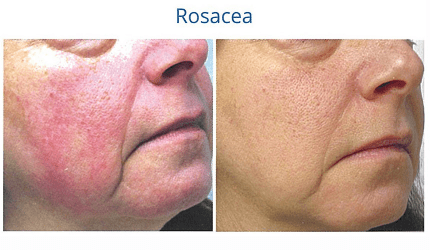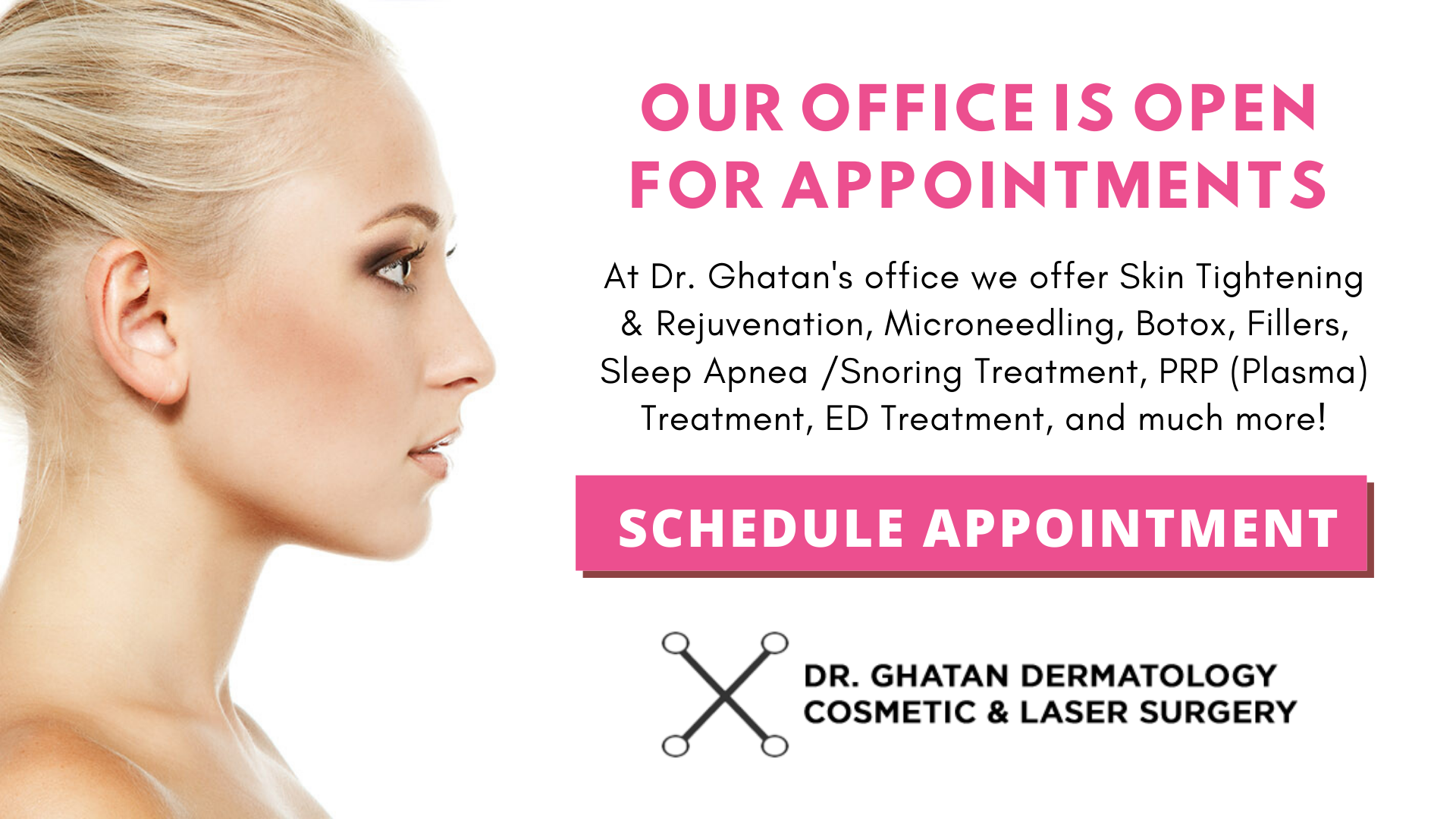A few of our treatment options for Rosacea:
- Photo Dynamic Therapy
- Excel V+
- Laser Genesis

What is Rosacea?
If you are one of those people who blush easily or turn ‘beet red’ when you are embarassed, then you may be one of the millions of people prone to a disorder called rosacea. This is a condition where anything that causes the blood vessels in the skin to open (dilate) can lead to diffuse redness of the face, a rash that looks just like acne, and broken blood vessels.
Most forms of rosacea are more common in women than in men. The majority of people with rosacea are between 40-60 years old. It is important to have an evaluation of redness of the face since there are several possible conditions that can cause this, some of which may be serious, and early evaluation and treatment can make a very big difference in outcome.
Types of Rosacea
There are four types of rosacea. The mildest type simply consists of occasional redness of the face, especially the forehead, central face and chin. In the second type, there is lasting redness with broken blood vessels, called telangiectasia, and red bumps that look like acne. In a more severe, third type of rosacea, there can be deeper cystic lesions that can be painful and lead to scarring. In the fourth type, more common in men, there is overgrowth of sebaceous glands (oil producing glands) of the nose leading to a bulbous nose (WC Fields had this). There is not necessarily progression from one stage to the next. It can start anywhere and stay there or it can worsen or improve based on treatment.
One aspect of this disease that is commonly overlooked is that rosacea can also affect the eyes, called ocular rosacea. Up to 60% of people with rosacea can have eye involvement. This can take the form of inflammation of the eyes and skin around the eyes, which can affect vision. People with rosacea that involves the eyes should be evaluated by their ophthalmologist and treated appropriately. Migraine headaches are also reported to be two to three times more common in rosacea sufferers.
Factors that Aggravate Rosacea
The exact cause of rosacea remains a mystery. However, anything that causes increased blood flow to the skin can aggravate rosacea. Some of the most common of these factors are:
- Increased temperature
- Hot showers
- Hot drinks
- Caffeine
- Alcohol
- Spicy foods
- Sun exposure
- Blushing
- Extremes in emotion
- Wind
- Cold
There is also a good chance that people with rosacea have increased numbers of mites in the hair follicles of the face; there are millions of hair follicles on the face. The offending mites are called Demodex folliculorum. They aggravate the skin and can cause redness and inflammation of the skin.
Treatment of Rosacea
Rosacea is generally treated by avoidance of factors that aggravate it (emotional stress, sunlight, hot beverages, spicy foods, alcohol, extremes of heat and cold) combined with a variety of prescription topical medications. Sunscreen should always be used. Your doctor may recommend a combination of oral antibiotics and topical medications, eventually tapering off the oral antibiotics with continued topical creams for maintenance.
There are several new treatments now available for treating this condition. Surgical treatment may be required for treatment of rhinophyma. Also, laser treatment is very effective for treating the broken blood vessels. This may also improve the acne-like lesions.
How Rosacea Starts
The first sign is rosy cheeks. This will progress into red patches that will appear on the skin for a few hours or days at a time. As it progresses the rd patches may not go away at all.
When Rosacea first appears, many people mistake the condition for sunburn, windburn and even acne. They wait for the condition to clear upon it’s own so they delay seeking treatment.
It is important to seek treatment as soon as sign’s appear. The earlier treatment is started, the quicker your rosacea will be brought under control.
Effects of Rosacea
Redness of the cheeks, chin and nose may appear first. Pimples, broken or enlarged blood vessels and an enlarged bumpy nose may result as the condition progresses.
It is important to remember that you cannot treat Rosacea yourself. Over the counter products are not effective, in fact they may aggravate the condition.
Avoid Rosacea Triggers
The following is a partial listing of things that can aggravate your rosacea symptoms.
Your physician can provide a complete listing.
Weather: Sun, strong wind, cold and humidity.
Physical exertions & emotional influences: Exercise, heavy lifting, stress, anxiety.
Beverages: Alcoholic beverages, hot drinks.
Foods: Hot and spicy foods, dairy products, coffee.
Rosacea Cure
Rosacea cannot be cured, but the right treatment will bring the condition under control.
Topical medications
A topical antibacterial and/or metronidazole cream may be needed
Oral Medications
Oral antibiotics may be advised to help get the condition under control and to treat flares.
NeoSkin by Aerolase™ Rosacea, Redness, and Veins
NeoSkin comprehensively addresses rosacea, redness, veins, and broken capillaries in a single, 20-25 minute treatment session. A common condition with skin aging is the appearance of redness and formation of veins and broken capillaries in the skin. Rosacea is a chronic disorder that is characterized by facial flushing and with time the gradual development of persistent facial redness and spider-like blood vessels. It is often punctuated by episodes of inflammatory papules (bumps), pustules (pimples), and swelling. Management for many people often includes avoidance of popular foods and alcohol as well as cosmetic camouflage, which can be expensive and time-consuming. Other diffuse redness including poikiloderma of civatte may be attributed by other factors such as exposure to UV rays and lifestyle, which can also be addressed by the NeoSkin treatment. The Aerolase Neo effectively addresses these conditions with deep-penetrating energy that suppresses the inflammation causing the redness. It also coagulates the unwanted veins and broken capillaries, which are then gradually cleared by the body’s natural immune response.

